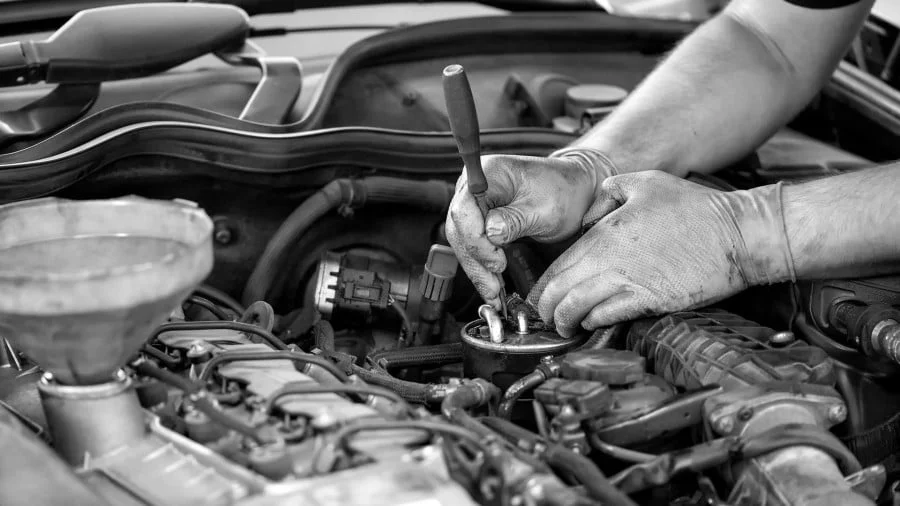In Which Embattled Manhood Rassles a Carburetor, and Is Discomfited
In times of desperation, such as being medically sidelined, columnists resort to the shameless practice of republishing old titles. It is embarrassing. But I am doing it.
The abyss is everywhere, the unknown chasm that lies beyond the world we think we understand. Especially in carburetors.The other day I went to the back yard to change the main jet on the carburetor that engages in respiration for my ’67 Dodge. It is a simple device, having none of the incomprehensible swirls of anti-pollutional hoses that festoon modern machines like malign linguini. Changing the jet is a simple matter of unscrewing one sorry little metal doughnut and replacing it with another. All you need is a screwdriver, long skinny fingers, four arms, and an ability to see through sheet metal.
Okay. I advanced on the old bucket with a box of tools and a Soldier of Fortune T-shirt: modern American manhood at its clear-eyed, technically adept finest. I scowled. I endeavored to look masterful. No office-serf like me can do anything practical without (a) a sense of wonder that it actually worked and (b) a giddy exultation at his prowess. Whenever I successfully repack the wheel bearings, I have an urge to put my foot on a log, beat my chest, and utter a long quavering shriek. Unfortunately the neighbors, jealous types, would send for a struggle buggy and a couple of big orderlies.
The hood went uay. Say “Ahhh.” I am the equal of anybody in my mastery of hoods. The float bowl came off easily. Anything mechanical comes apart easily, often leaping spontaneously into more parts than you knew it had. The Second Law of Thermodynamics, which insists that the universe tends to disorder with devilish single-mindedness, was no doubt discovered by a physicist working on his carburetor.
The old jet came out easily. The new one screwed in simply…well, almost simply, if only my fingers would fit behind the float, but there was no serious problem. I’d just take a long screwdriver, hold the jet balanced with the tip, turn it slowly…. Actually, there was no great difficulty at all. I merely put my foot on the battery for balance, holding a small flashlight in my mouth to shine into the carburetor, held the float with one hand and guided the jet with the other. Easy. Unfortunately it didn’t leave a hand to hold the screwdriver. The solution was really quite simple. All I had to do was….
After 45 minutes, my wife came out. She is by profession a harpsichordist and has the eye-hand coordination to disassemble a watch while bouncing on a trampoline. She does not, however, understand masterfulness. She tried to insert the jet a few times.
“This is ridiculous. Are you sure this is the right part?”
It was the wrong question to ask of embattled prowess.
My father came out to try. He had been skulking about, waiting for me to fail entirely so that he would be more impressive when he succeeded. He assumed a masterful expression and had at the vile device with the deft touch of a trained surgeon.
“Damn!”
“What?” I asked.
“I dropped it.”
A principle of automotive mechanics is that all parts smaller than a tire look exactly like gravel. I put the patient jalopy in neutral and we pushed it back a yard to look beneath it. We got down on our knees and began peering at the driveway trying to convey by a sort of panicked casualness that we were in command of the situation. Nothing. I began throwing gravel piece by piece into the woods on the theory that whatever remained would have to be the jet.
Judging by the sun, we had about three hours of daylight left.
Having found the thing at last, my father impaled in by its slot on an outsize screwdriver and began poking it at the carburetor like a dirk. He certainly looked masterful. I imagined him as a sort of latter-day D’Artagnan crossing swords with the enemies of the Crown, and leaving them with carburetor jets screwed into their breasts.
“Is it working?” I asked.
“Nothing to it. Used this trick for years, putting number-10 screws into junction boxes. Damn!”
We rolled the car back again and began searching for the jet. Five minutes later we did it again. My father looked down the driveway with a masterful expression that was beginning to be tinged with realism. “I calculate we’ve got about 600 more feet of driveway,” he said.
Automotive repair breaks into two phases-the first, in which the mechanic wants to fix the device, and the second, in which he wants to kill it. The difference between an obstacle and an enemy is about an hour and a half. Rage builds. It begins as a sort of interior itch accompanied by a desire to flex the large muscles. Then the fingers begin to curl uncontrollably. They are wondering what part of a carburetor might be the neck. Yet you still have to work delicately, precisely, or else call a mechanic. We tried.
“Damn!”







